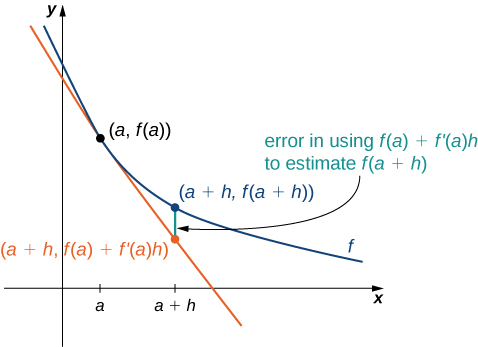- Calculate how quantities change on average over time
- Use rates of change to figure out how an object’s position, speed, and acceleration are changing over time
- Estimate future population sizes using current data and how fast the population is growing
- Use derivatives to determine the cost and revenue of producing one more unit in a business
Amount of Change Formula
One application of derivatives is to estimate an unknown value of a function at a point by using a known value of the function at some given point together with its rate of change at that given point.
If [latex]f(x)[/latex] is a function defined on an interval [latex][a,a+h][/latex], then the amount of change of [latex]f(x)[/latex] over the interval is the change in the [latex]y[/latex] values of the function over that interval and is given by:
The average rate of change of the function [latex]f[/latex] over that same interval is the ratio of the amount of change over that interval to the corresponding change in the [latex]x[/latex] values. It is given by:
As we already know, the instantaneous rate of change of [latex]f(x)[/latex] at [latex]a[/latex] is its derivative,
For small enough values of [latex]h, \, f^{\prime}(a)\approx \frac{f(a+h)-f(a)}{h}[/latex]. We can then solve for [latex]f(a+h)[/latex] to get the amount of change formula:
We can use this formula if we know only [latex]f(a)[/latex] and [latex]f^{\prime}(a)[/latex] and wish to estimate the value of [latex]f(a+h)[/latex]. For example, we may use the current population of a city and the rate at which it is growing to estimate its population in the near future.
As we can see in Figure 1, we are approximating [latex]f(a+h)[/latex] by the [latex]y[/latex] coordinate at [latex]a+h[/latex] on the line tangent to [latex]f(x)[/latex] at [latex]x=a[/latex]. Observe that the accuracy of this estimate depends on the value of [latex]h[/latex] as well as the value of [latex]f^{\prime}(a)[/latex].

average rate of change
The average rate of change of a function [latex]f[/latex] over the interval [latex][a,a+h][/latex] is the ratio of the amount of change in [latex]f[/latex] over that interval to the corresponding change in [latex]x[/latex] values.
The average rate of change is given by:
If [latex]f(3)=2[/latex] and [latex]f^{\prime}(3)=5[/latex], estimate [latex]f(3.2)[/latex].